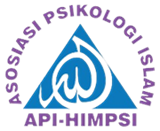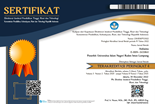Pengaruh Integrative Behavioral Couple Therapy terhadap Pola Asuh Coparenting Orangtua
Abstract
Keywords
Full Text:
PDFReferences
American Psychiatric Assocation. (2013). Diagnostic and Statistical Manual of Mental Disorders (5th ed.). USA: American Psychiatric Association.
Barker, J., Mccarthy, P., Jones, M., & Moran, A. (2011). Single-case research methods in sport and exercise psychology. New York: Routledge.
Brown, J. (1999). Bowen family system theory and practice : illustration and critique. New Zealand: Australian Academic Press.
Bynion-Teah , M., Blumenthal, H., Bilsky, S. A., Cloutier, R. M., & Leen-Fledneer, E. W. (2017). Dimensions of parenting among mothers and fathers in relation to social anxiety among female adolescent. Journal of Adolescent, 60, 11-15.
Eroglu S., T. S. (2012). DSM-IV diagnostic and statistical manual of mental disorder. USA: American Psychiatric Organization.
Feinberg, M. E. (2012). The internal structure and ecological context of coparenting: a framework for research and intervention parenting: science and practice. Parenting : science and practice , 95-131.
Fletcher, A. C., Walls, J. K., Cook, E. C., Madison, K. J., & Bridges, T. H. (2009). Parenting styles as a moderator of association between maternal disciplinary strategies and child well-being. Journal of Family(29), 1724-1744.
Flouri, E., Midouhas, E., & Narayanan, M. K. (2016). The relationship between father involvement and child problem behaviour in intact families : a 7-year cross-lagged study. Journal of Abnormal Child Psychology, 44, 1011-1021.
Halldorsson, B., & Creswell, C. (2017). Social anxiety in pre-adolescent children: what do we know about maintenance? Behaviour research and therapy, 99, 19-36.
Hewison, D., Casey , P., & Mwamba, N. (2016). The Effectiveness of Couple Therapy: Clinical Outcomes in a Naturalistic United Kingdom Setting. Psychoterapy, 377-387.
Hugil, M., Fletcher, I., & Berry, K. (2017). Investigation of associations between attachment, parenting and schizotypy. Journal of Affective Disorders, 86-94.
Jackson, C., & Dickinson, D. M. (2009). Developing parenting programs to prevent child health risk behavior: a practice model. Health education research, 24(6), 1029-1042.
Kearney, C. A. (2005). Social anxiety and social phobia in youth : characteristic, assesment and psychological treatment. USA: Springer Science.
Kerig, P. K., Ludlow, A., & Wenar, C. (2012). Developmental psychopatology. UK: Mc-Graw Hill.
Lavner, J. A., Barton, A. W., & Beach, S. R. (2019). Improving couples relationship functioning leads to improved coparenting : a randomized controlled trial with rural african american couples. Behavior therapy, 1016-1029.
Lebow, J. L. (2005). Handbook of clinical family therapy. New Jersey: John Wiley & Son Inc.
Lestari, S. (2012). Psikologi keluarga : penanaman nilai dan penanganan konflik dalam keluarga. Jakarta: Kencana.
McDaniel, B. T., Galovan, A. M., Craven, J. D., & Drouin, M. (2018). “Technoference” and implications for mothers' and fathers' couple and coparenting relationship quality. Computers in Human Behavior, 303-313.
Ooi, L. L., Nocita, G., Coplan, R. J., Zhu, J., & Rose-Krasnor, L. (2017). Beyond bashful: Examining links between social anxiety and young children's socio-emotional and school adjustment. Early Childhood Research Quarterly, 41(April 2016), 74-83.
Papalia, E. D., & Feldman, R. T. (2014). Menyelami Perkembangan Manusia; Experience Human Development. Jakarta: Salemba Humanika.
Perone, M., & Hursh, D. E. (2005). APA Handbook of behavior analysis . USA: APA.
Pudjibudojo, J. K., Handadari, W., Wulandar, P. Y., Kesumaningsari, N. P., Bawono, Y., Elgeka, H. W., et al. (2019). Bunga rampai psikologi perkembangan: memahami dinamika perkembangan anak. Sidoarjo: Zifatama Jawara.
Sprenkle, D. H., & Piercy, F. P. (2005). Research methods in family therapy. New York: The Guilford Press.
Sugiyanto. (2009, 01 01). Manipulasi : Karakteristik Eksperimen. Buletin Psikologi, pp. 98-108.
Sunanto , J., Takeuchi, K., & Hideo , N. (2005). Pengantar penelitian dengan subyek tunggal. Japan: University of Tokyo.
Supratiknya, A. (2011). Merancang program dan modul psikoedukasi. Yogyakarta: Universitas Sanata Dharma.
Tifrere, M. (2018). Blend : creating a loving family after divorce. New York: Tarcherperigee.
Zhou, M. (2016). The roles of social anxiety, autonomy, and learning orientation in second language learning: A structural equation modeling analysis. System, 63, 89-100.
DOI: http://dx.doi.org/10.24042/ajp.v3i1.6891
Refbacks
- There are currently no refbacks.
Copyright (c) 2020 ANFUSINA: Journal of Psychology











